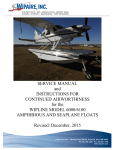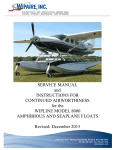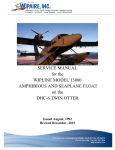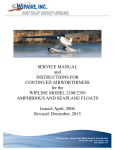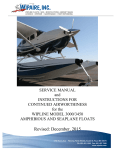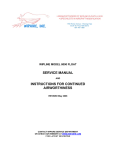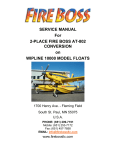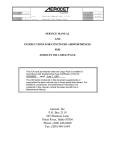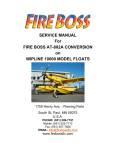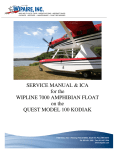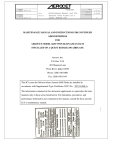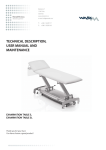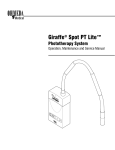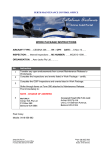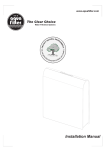Download Model 4000 Service Manual
Transcript
WIPLINE FLOATS • SKIS • MODIFICATIONS • AIRCRAFT SALES AVIONICS • INTERIOR • MAINTENANCE • PAINT REFINISHING SERVICE MANUAL for the WIPLINE MODEL 4000 AMPHIBIOUS AND SEAPLANE FLOATS Issued: JUNE, 1992 Revised: December, 2015 1700 Henry Ave – Fleming Field (KSGS), South St. Paul, MN 55075 Ph: 651.451.1205 Fax: 651.457.7858 www.wipaire.com WIPLINE MODEL 4000 SERVICE MANUAL THIS PAGE INTENTIONALLY LEFT BLANK Page 2 of 41 1002552 • Rev B WIPLINE MODEL 4000 SERVICE MANUAL TABLE OF CONTENTS SECTION PAGE LOG OF REVISIONS ...................................................................................................... 5 NEW CUSTOMER INFORMATION ................................................................................ 6 1.0 GENERAL ................................................................................................................. 9 2.0 FLOAT HULL MAINTENANCE.................................................................................. 9 2.1 GENERAL ............................................................................................................. 9 2.2 CLEANING ............................................................................................................ 9 3.0 CORROSION .......................................................................................................... 10 4.0 FLOAT HANDLING AND JACKING ........................................................................ 10 5.0 RETRACT SYSTEM OPERATION AND MAINTENANCE ...................................... 11 5.1 DESCRIPTION AND OPERATION...................................................................... 11 5.2 ADJUSTMENT / TEST ........................................................................................ 11 5.3 SERVICE SCHEDULE ........................................................................................ 12 FIGURE 5-1 SCHEMATIC HYDRAULIC SYSTEM.................................................... 21 FIGURE 5-2 SCHEMATIC: LANDING GEAR ELECTRICAL SYSTEM ..................... 22 FIGURE 5-3 MAIN GEAR ACTUATION SYSTEM..................................................... 23 FIGURE 5-4 MAIN GEAR LOCKING SYSTEM ......................................................... 24 FIGURE 5-5 NOSE GEAR RETRACTION SYSTEM ................................................. 25 FIGURE 5-6 SECTION MAIN GEAR OLEO .............................................................. 26 FIGURE 5-7 ASSEMBLY MAIN WHEEL AND BRAKE ............................................. 27 6.0 MAIN GEAR ............................................................................................................ 28 6.1 MAIN OLEO ......................................................................................................... 28 6.1.1 DESCRIPTION.............................................................................................. 28 6.1.2 REMOVAL/INSTALLATION .......................................................................... 28 6.1.3 SERVICE ...................................................................................................... 28 6.3 MAIN WHEELS AND BRAKES............................................................................ 29 7.0 NOSE GEAR ........................................................................................................... 30 7.1 DESCRIPTION .................................................................................................... 30 7.2 SERVICE SCHEDULE ........................................................................................ 30 7.3 NOSE BOX TRACK WEAR ................................................................................. 30 8.0 WATER RUDDER RETRACTION AND STEERING SYSTEM ............................... 31 1700 Hen1002552 • Rev B Page 3 of 41 WIPLINE MODEL 4000 SERVICE MANUAL 8.1 DESCRIPTION .................................................................................................... 31 8.2 ADJUSTMENT..................................................................................................... 31 8.3 SERVICE SCHEDULE ........................................................................................ 31 9.0 REPAIRING FLOAT HULL SKINS .......................................................................... 31 FIGURE 9-1 TYPICAL SKIN REPAIR ....................................................................... 32 FIGURE 9-2 TYPICAL SKIN REPAIR ....................................................................... 33 FIGURE 9-3 TYPICAL SKIN REPAIR ....................................................................... 34 FIGURE 9-4 TYPICAL REPAIR BOTTOM SKIN TO KEEL INSTRUCTIONS ........... 35 FIGURE 9-5 TYPICAL REPAIR BOTTOM SKIN TO KEEL INSTRUCTIONS ........... 36 FIGURE 9-6 TYPICAL REPAIR BOTTOM SKIN TO KEEL (ALT) INSTRUCTIONS . 37 10.0 REPAIRING FLOAT HULL EXTRUSIONS ............................................................ 38 FIGURE 10-1 TYPICAL REPAIR SPLICE OF KEEL ................................................. 39 FIGURE 10-2 TYPICAL REPAIR SPLICE OF CHINE ............................................... 40 FIGURE 10-3 TYPICAL CAP SPLICE TO KEEL ....................................................... 41 Page 4 of 41 1002552 • Rev B WIPLINE MODEL 4000 SERVICE MANUAL LOG OF REVISIONS REV PAGES DESCRIPTION DATE A 9, 22 Added an inspection time limit and tolerances for the Nose Block Track wear. 4/18/06 B ALL C 13, 14 D 5, 13, 14 Reformat of entire document, Add green grease as approved grease Added Shear Torque Chart, PR 1440 C Sealant and Tef-Gel, Removed Warranty Claim Form. Added Dow Corning DC4, Corrosion X, and Mobil Aviation Grease SHC 100 to approved product list. Modified torque limit section 1700 Hen1002552 • Rev D 4/16/2013 5/26/2015 12/4/2015 Page 5 of 41 WIPLINE MODEL 4000 SERVICE MANUAL NEW CUSTOMER INFORMATION Customer Name Billing Address Shipping Address Phone Number Fax Number Purchasing Contact Phone Number E-Mail Fax Number Accounts Payable Contact Phone Number E-Mail Fax Number Type(s) of Aircraft Owned or Maintained Model(s) of Floats and Skis Owned or Maintained FedEx and/or UPS account number (if applicable) Please return to Wipaire Customer Service: Fax 651-306-0666 Page 6 of 41 Phone 651-306-0459 [email protected] 1002552 • Rev B WIPLINE MODEL 4000 SERVICE MANUAL THIS PAGE INTENTIONALLY LEFT BLANK 1700 Hen1002552 • Rev B Page 7 of 41 WIPLINE MODEL 4000 SERVICE MANUAL INTRODUCTION This manual describes the general service and maintenance for the float hull, gear systems, installation, and control parts. For service and repair not covered by this manual contact Wipaire Customer Service. The service products referred to throughout this manual are described by their trade name and may be purchased from the Wipaire Parts Department. To contact Wipaire for technical support or parts sales call write or email: Wipaire, Inc. 1700 Henry Avenue – Fleming Field South St. Paul, MN 55075 Telephone: (651) 306-0459 Fax: (651) 306-0666 Website: www.wipaire.com Email: [email protected] Page 8 of 41 1002552 • Rev B WIPLINE MODEL 4000 SERVICE MANUAL 1.0 GENERAL The model 4000 seaplane or amphibious float is an all aluminum constructed float with watertight compartments. The actual displacement in fresh water for each float is 3802 pounds buoyancy for the seaplane and 3672 pounds buoyancy for the amphibian. The amphibian float is geometrically the same as the seaplane except for the addition of landing gear and internal structure for the gear. The water rudder system is cable operated with ball bearing pulleys. Water rudder cables tie into the existing aircraft rudder system. The main landing gear has dual 5.00 x 5 6-ply tires and the nose landing gear has one 4.10 x 4 4ply tire. The gear system is hydraulically actuated and driven by one pump located on the engine firewall on a Cessna 185 and in the aft fuselage at Sta. 159.3 on a Cessna 206. Brakes are hydraulic and have a caliper on each main wheel for a total of four brakes. Steering on land is accomplished by differential braking. The nose wheels are full castering. Access to the float interior is accomplished by removing covers on the top deck and four covers inside the wheel well. When necessary, water inside the float hulls may be removed through pump out cups located on the outboard edge of each float top skin. 2.0 FLOAT HULL MAINTENANCE 2.1 GENERAL The float structure is manufactured entirely of 2024-T3 or 6061-T6 corrosion resistant aluminum sheet and extrusions. Skins on the inside are primed with a 3M SCOTCHWELD primer after being cleaned and acid-etched. Exterior surfaces are cleaned and alodined. Surfaces are then primed with an epoxy-based primer and finished with an enamel color paint. 2.2 CLEANING The outside of the float should be kept clean by washing with soap and water, with special care taken to remove engine exhaust trails, water line marks, and barnacle deposits. After salt water operation, washing with fresh water should be done daily with special attention to hard-to reach places, such as seams, wheel well, etc. The float interior should be flushed if salt water enters the compartments. If storing inside, remove inspection covers so interior will dry. 1700 Hen1002552 • Rev B Page 9 of 41 WIPLINE MODEL 4000 SERVICE MANUAL 3.0 CORROSION Corrosion is a reaction that destroys metal by an electrochemical action that converts metal to oxide. Corrosion is accelerated when in contact with dissimilar metals such as aluminum and steel, or any material that absorbs moisture like wood, rubber, or dirt. The primary means of detection of corrosion is visual. The most obvious sign is a corrosive deposit of white powder. Other signs are discoloration of the metal surface or bubbles and blisters under the painted surface. Light corrosion may be removed by light hand sanding or chromic acid. Moderate and severe corrosion (blistering, flaking, and pitting) may be removed by heavy sanding or grinding, and applying chromic acid. No more than 1/3 the thickness of skin material should be removed before complete replacement or reinforcement of an area is necessary. After removing the corroded area, restore area to original finish (prime and enamel). Maintaining the float inside and outside finishes by washing after salt water operations will help protect the float from corrosion. Periodically, all hardware should be covered with a water-proof grease, or paralketone. Under salt water conditions, bolts should be removed at least once a year and grease reapplied to the shafts, heads, and nuts. 4.0 FLOAT HANDLING AND JACKING To jack the floats for servicing tires, oleos, brakes, etc., it is recommended that a floor type jack (2 ton min.) be used. These jacks are commonly used for auto repair. The jack should be positioned on the keel center line approximately 12 inches forward of the step. The jack should contact the keel squarely and if room permits, slip a board between the jack and keel. Raise the float slowly, making sure the aircraft stays balanced. After raising, block up the keel in several places and lower the jack. Raise only one float at a time, with the opposite float landing wheels chocked. For raising the aircraft for float installation and removal, use the lifting rings provided at the wing attach points. Aircraft may be lifted by spreader bars with a launching dolly. WITH CAUTION, lift on both spreader bars as close to float hull as possible. Lift unloaded aircraft only! Page 10 of 41 1002552 • Rev B WIPLINE MODEL 4000 SERVICE MANUAL 5.0 RETRACT SYSTEM OPERATION AND MAINTENANCE 5.1 DESCRIPTION AND OPERATION Retraction and extension of the main and nose landing gear is effected by a hydraulic actuation system shown schematically in figure 5-1. The gear system is hydraulically actuated and driven by one pump located on the engine firewall on a Cessna 185 and in the aft fuselage at Sta. 159.3 on a Cessna 206. A pressure of between 500 psi and 1000 psi is maintained in the supply line. When the pressure falls below 500 psi, the pressure switch activates the pump solenoid, providing power to the pump. When the pressure reaches 1000 psi, the pressure switch deactivates the solenoid and the pump motor stops. Figure 5-2 shows the electrical schematic of the system. A check valve on the output side of the pump retains pressure in the system while the pump is off. The pump has an internal relief valve which directs oil back to the pump reservoir when the line pressure exceeds 1200 psi. The system also has an internal relief valve to protect against thermal expansion when line pressure exceeds 1900 psi. The selection of gear up or gear down is accomplished by a cockpit mounted control valve. Each float gear has individual indicator lights on the control valve allowing the pilot to confirm that each gear has fully retracted or extended. An emergency hand pump is provided, in case of total electric pump failure, or loss of fluid. The reservoir has additional hydraulic fluid, available only to the hand pump. The main gear is mechanically locked in both up and down positions. Locking and unlocking is effected utilizing a small amount of lost motion of the actuator rod. Retraction takes place when pressure is exerted on the actuator piston driving the collar along the slide tube (see figure 5-3). The lock is tripped when the follower slides up the contoured track in the actuator as shown in figure 5-4. A reverse process effects extension. Gear position light proximity switches are closed when the appropriate hook (containing the magnetic material) nests over the locking bar. The nose gear has an over-center down lock. Retraction occurs when pressure is applied to the forward face of the actuator piston and the carriage is drawn along the tracks in the nose box as shown in figure 55. Gear position light proximity switches are closed when the piston containing the magnetic material has reached either end of its travel. 5.2 ADJUSTMENT / TEST Adjustment of actuator stroke is provided at the ends of the piston rods on the nose gear; the main gear is not adjustable. These are pre-set at the factory to ensure that gears are locked at the end of each stroke and that correct indication is given on the cockpit console. NOTE: The length of the nose gear rod is adjusted such that the over-center knuckle (brass) rollers just bottom out on the down side and the piston just bottoms out on the mounting flange. The up stop nests in the up-stop pin. The only adjustment necessary on the main gear is the height that the locks are raised by the cam. The adjustment screw figure 5-4 should be set such that the locks are raised enough to unlatch the hook for unlocking, but still making sure that they are fully down on the lock bar (top of hook approximately horizontal) when locked. 1700 Hen1002552 • Rev B Page 11 of 41 WIPLINE MODEL 4000 SERVICE MANUAL Nose gear proximity switches are set by sliding the mounting clips on the cylinders to a position such that the light goes out when the over-center truck is about 1/4 inch form the bottomed position while traveling in the up direction. Lights should come on about 1/8 inch from the bottomed position while traveling in the down direction. The main gear proximity switches (figure 5-4) are adjusted by loosening the mounting screws and positioning them such that the light goes out when the lock hook is raised about 1/8 inch off its nested position and comes on again upon nesting. The system automatically bleeds, provided sufficient oil is maintained in the reservoir. To check the fluid level, fill the reservoir with hydraulic oil and cycle the gear. If the reservoir empties (i.e. fluid disappears in sight glass) stop the cycle by pulling the circuit breaker on the control panel. Fill the reservoir again and complete the cycle. Continue this procedure until the fluid level in the reservoir stabilizes (it will vary in level between up and down positions). If the fluid level continues to decline during gear cycles, check for external leaks. 5.3 SERVICE SCHEDULE As coded in the Inspection Time Limits chart in this section, there are items to be checked each 25, 50, 100, and 200 hours. Also, there are notes on special items which may require servicing at more frequent intervals. When conducting an inspection at 25 hours, all items marked for 25 hours would be accomplished. When conducting an inspection at 50 hours, the 25 and 50-hour items would be accomplished. When conducting an inspection at 100 hours, the 25, 50, and 100-hour items would be accomplished. When conducting an inspection at 200 hours, the 25, 50, 100, and 200-hour items would be accomplished. A complete inspection (Annual Inspection) would include all 25, 50, 100, and 200-hour items. When servicing float hull and amphibian components, below is list of recommended lubricants and “protection” products. This lists products used by Wipaire during assembly of the floats. There may be equivalent products that are just as satisfactory for protection. It is recommended if trying different products, to inspect them frequently so as to determine their effectiveness. Page 12 of 41 1002552 • Rev B WIPLINE MODEL 4000 SERVICE MANUAL Protection of nuts, bolts, hydraulic lines or metal surfaces Zip D-5029NS Corrosion Inhibiting Compound Zip Chemical Company CRC – SP400 Soft Seal CRC Industries Tef-Gel Ultra Safety Systems, Inc. General Lubricants LPS 1, LPS 2 and LPS 3 LPS Industries Electrical Insulating Compound Dow Corning 4 (DC4) Dow Corning Corporation Wheel Bearings *HCF Grease, P/N 605 HCF Industries Float Sealant 890 B2 or B4 Pro Seal Company *Aeroshell 22 Shell Global Solutions PR 1440 C PPG Aerospace *Green Grease, Multi-Purpose Green Grease Inc. 1422 B2, B4 or B6 Pro Seal Company Rust Protection Boeshield T9 Rut Protection Boeing Company RTV Silicones General Electric SIKAFLEX 201 or 252 Sika Manufacturing ACF-50 Rust Protection Corrosion X Corrosion Technologies Corp. Telflon Spray 6P-730A Comet Industries Hydraulic Fluid Mil-H-5606 *If existing grease cannot be identified you must lubri-flush all float grease fittings until visibly exhausting all old grease and new grease is coming out. Additionally if you cannot determine existing grease in wheel bearings, completely clean and repack bearings with new grease. As general inspection guidelines, each of the following areas should be inspected for their own unique attributes: Movable Parts For lubrication, servicing, security of attachment, binding, excessive wear, safetying, proper operation, proper adjustment, correct travel, cracked fittings, security of hinges, defective bearings, cleanliness, corrosion, deformation, sealing, and tension. Fluid Lines and Hoses For leaks, cracks, dents, kinks, chafing, security, corrosion, and deterioration. 1700 Hen1002552 • Rev D Page 13 of 41 WIPLINE MODEL 4000 SERVICE MANUAL Metal Parts For security of attachment, cracks, metal distortion, broken welds, corrosion, condition of paint, and any other apparent damage. Wiring For security, chafing, burning, defective insulation, loose or broken terminals, corroded terminals. Bolts in Critical Area For corrosion, correct torque when installed, or when visual inspection indicates a need for a torque check. Nut torque should be applied depending on the hardware application, unless the torque is specified for a certain joint in this manual or installation drawings. **Tension Application Torque Limits NutIn-lbs Bolt Size Min. Max. 8-36 12 15 10-32 20 25 1/4-28 50 70 5/16-24 100 140 3/8-24 160 190 7/16-20 450 500 1/2-20 480 690 9/16-18 800 1,000 5/8-18 1,100 1,300 3/4-16 2,300 2,500 7/8-14 2,500 3,000 1-14 3,700 4,500 1 1/8-12 5,000 7,000 1 1/4-12 9,000 11,000 **Shear Application Torque Limits NutIn-lbs Bolt Size Min. Max. 8-36 7 9 10-32 12 15 1/4-28 30 40 5/16-24 60 85 3/8-24 95 110 7/16-20 270 300 1/2-20 290 410 9/16-18 480 600 5/8-18 600 780 3/4-16 1,300 1,500 7/8-14 1,500 1,800 1-14 2,200 3,300 1 1/8-12 3,000 4,200 1 1/4-12 5,400 6,600 **A Torque of 80% should be used when Tef-Gel is applied to the bolt. Some additional general maintenance areas are as follows: Nose and Main Gear Tracks Clean and lubricate with a dry Teflon coating spray. Joints Spray all joints with light penetrating oil such as LPS 3 to ensure lubrication at all times. Electrical Connections Apply SP-400 SOFT SEAL or LPS 500 to all electrical connections to prevent corrosion. Hydraulic Fluid For use in all hydraulic systems, including brakes: MIL-H-5606. Page 14 of 41 1002552 • Rev D WIPLINE MODEL 4000 SERVICE MANUAL INSPECTION TIME LIMITS 25 General Hulls and Struts Placards Float Installation HOURS 50 100 200 X X X Spreader bars Float structure (interior) X Baggage compartment covers and seals inspect for condition, security operation, excessive wear. X Pumper Tube Installation - inspect for condition, security, routing of hoses X Water Rudder Boots - inspect for cuts, tears, and condition. X Water Rudder Steering and retract systems - inspect the following: cables for broken wire; cable fittings for cable slippage, cracks and distortion; cable pulleys for freedom of rotation and cable guard pins for presence; rigging. Electrical System INSP. X Float exterior - inspect for damage, wrinkled metal, corrosion, paint loss, etc. Struts and attach fittings Water Rudder System Mech. Initial Rt. Lt. X Water Rudder blades and posts - inspect for damage, security of attachment, corrosion, paint, rigging. X Pump and indicator light wiring - inspect for chafing, broken or loose terminals and general condition. X Solenoids - inspect wiring, mounting and general condition. X 1700 Hen1002552 • Rev B Page 15 of 41 WIPLINE MODEL 4000 SERVICE MANUAL INSPECTION TIME LIMITS (CONT.) 25 Landing Gear Systems Pump motors - inspect wiring, mounting and general condition. Pressure switches - inspect wiring, mounting and general condition. Lubricate nose gear tracks. Nose gear Box/Block tracks measured at slide route for wear, .050 inches or less wear tolerance Nose gear pivot blocks and forks inspect for condition, lubrication, corrosion, paint. Nose and main wheel bearing - grease Zerk fittings. Inspect and measure wear on Nose Gear Track Box Hydraulic Fluid Level Wheels and tire - inspect for wear, pressure, condition. Brake Assemblies - inspect for wear, corrosion, leakage. Hydraulic Fluid Screen - clean and inspect. NOTE: if floats sit for extended periods of time (I.e. if removed during winter months), screen should be cleaned before putting floats back into service. Hydraulic fluid in reservoir should be checked for moisture or other contaminates and changed if necessary. Main and nose gear actuator, assemblies - inspect for condition, lubrication, leakage, corrosion and cleanliness. Nose gear springs - scotch-ply springs, inspect for cracks, delamination and paint. Page 16 of 41 1002552 • Rev B HOURS 50 100 200 X X X X X X X X X X X X X Mech. Initial Rt. Lt. INSP. WIPLINE MODEL 4000 SERVICE MANUAL INSPECTION TIME LIMITS (CONT.) 25 Landing Gear Systems Main gear drag link garlock bushings inspect for condition, lubrication, corrosion. Main gear oleos - inspect for evidence of leakage, proper extension, check cylinder for corrosion, pitting, cleanliness and security. Hydraulic lines and fittings - inspect for leaks, condition and security. Hydraulic manifolds (if equipped) inspect for condition, security and leaks. Brake system plumbing - inspect for leaks, condition and security. Main gear oleos - service (fluidpressure) Perform retraction test: Inspect main gear up and down hooks for proper engagement HOURS 50 100 200 INSP. X X X X X X X Inspect nose gear trolley for proper travel. X Inspect nose gear for excessive side play in the down position. X Perform emergency gear extension (if equipped) X Nose and main wheel bearings disassemble and inspect Mech. Initial Rt. Lt. X 1700 Hen1002552 • Rev B Page 17 of 41 WIPLINE MODEL 4000 SERVICE MANUAL THIS PAGE INTENTIONALLY LEFT BLANK Page 18 of 41 1002552 • Rev B WIPLINE MODEL 4000 SERVICE MANUAL TROUBLE SHOOTING 1. PROBLEM - Power pack does not run after gear selection. PROBABLE CAUSE a. Circuit breaker has failed b. Pressure switch not pulling in at low cut in. c. Solenoid switch not pulling in. d. Faulty pump motor. e. Motor not properly grounded. VERIFICATION AND REMEDY a. Reset circuit breaker. b. Short across pressure switch leads and see if motor runs. If motor operates, replace pressure switch. c. Short across solenoid pressure switch leads and see if motor runs. If motor operates, replace solenoid pressure switch. d. If c. above does not produce results and it is verified that voltage was actually applied to motor, it can be assumed motor is bad or not properly grounded. e. Check motor ground. 2. PROBLEM - Powerpack does not shut off after gear reaches position. PROBABLE CAUSE a. Faulty pressure switch. b. Faulty or dirty pressure relief valve allowing insufficient pressure buildup. REMEDY a. Replace pressure switch. b. Clean and check relief valve. 3. PROBLEM - Powerpack shuts off before gear reaches position. PROBABLE CAUSE a. Binding or jammed gear retractor, which causes pressure to build up (and stay up), and pressure switch shuts off powerpack. REMEDY a. Repair retractor. 4. PROBLEM - Powerpack cycles on and off after gear is in position. PROBABLE CAUSE a. Internal hydraulic leak. b. External hydraulic leak. REMEDY a. Verify leak is not external by checking fluid level in reservoir and looking at couplings for oil leaks. If no external leaks are found, disconnect and cap off the hydraulic actuators one at a time and find the leaky one by process of elimination. If isolating entire system still indicates internal leak, powerpack check valve (located in pressure port of pump) is bad and needs replacement or reseating. b. Visually inspect lines, cylinders, and hoses and replace as necessary. 1700 Hen1002552 • Rev B Page 19 of 41 WIPLINE MODEL 4000 SERVICE MANUAL 5. PROBLEM - Powerpack cycles on and off during gear cycle. PROBABLE CAUSE a. Binding in retraction unit. b. Pressure switch cut off limit too low. REMEDY a. Investigate for free operation. Check gear that retracts last. b. Replace pressure switch. 6. PROBLEM -Slow gear operation cycle (considerably longer than 30 seconds). PROBABLE CAUSE a. Plugged oil screen. b. Poor electrical connection to motor. c. Poor motor. d. Worn pump gears. REMEDY a. Clean intake screen located inside reservoir tank. b. Connect motor direct to 12/24 volt source and note its operation; if good, wire connection is bad; if operation poor, motor needs overhaul. c. Covered in b. above. d. Replace pump. 7. PROBLEM - Circuit breaker pops during cycle. PROBABLE CAUSE a. Wire connections bad or corroded. b. Bad motor brushes. c. Bad circuit breaker. REMEDY a. Clean and protect terminal with grease. b. Overhaul motor. c. Replace circuit breaker. Page 20 of 41 1002552 • Rev B WIPLINE MODEL 4000 SERVICE MANUAL FIGURE 5-1 SCHEMATIC HYDRAULIC SYSTEM 1700 Hen1002552 • Rev B Page 21 of 41 WIPLINE MODEL 4000 SERVICE MANUAL FIGURE 5-2 SCHEMATIC: LANDING GEAR ELECTRICAL SYSTEM Page 22 of 41 1002552 • Rev B WIPLINE MODEL 4000 SERVICE MANUAL FIGURE 5-3 MAIN GEAR ACTUATION SYSTEM 1700 Hen1002552 • Rev B Page 23 of 41 WIPLINE MODEL 4000 SERVICE MANUAL FIGURE 5-4 MAIN GEAR LOCKING SYSTEM Page 24 of 41 1002552 • Rev B WIPLINE MODEL 4000 SERVICE MANUAL FIGURE 5-5 NOSE GEAR RETRACTION SYSTEM 1700 Hen1002552 • Rev B Page 25 of 41 WIPLINE MODEL 4000 SERVICE MANUAL FIGURE 5-6 SECTION MAIN GEAR OLEO Page 26 of 41 1002552 • Rev B WIPLINE MODEL 4000 SERVICE MANUAL FIGURE 5-7 ASSEMBLY MAIN WHEEL AND BRAKE 1700 Hen1002552 • Rev B Page 27 of 41 WIPLINE MODEL 4000 SERVICE MANUAL 6.0 MAIN GEAR 6.1 MAIN OLEO 6.1.1 DESCRIPTION Shock absorption for the main landing gear is provided by a hydraulically dampened air spring. Figure 5-6 shows the main components. The oil and air share a common chamber. When the oleo is collapsed, the oil is forced through the main orifice, compressing the air in the upper cylinder. Extension reverses this process. The extended oleo is initially set at the factory to 350 psi no load. In-field adjustment of air pressure is described in section 6.1.3. 6.1.2 REMOVAL/INSTALLATION Removal of the oleo assembly is accomplished by jacking the aircraft and removing the top oleo bolt and the bolt attaching the oleo to the landing gear yoke. The slide tube carriage must be moved forward approximately 1" to remove the top oleo bolt. In order to remove the lower bolt it is necessary to remove the wheel on the head side of the bolt or deflate the tire. WARNING: It is important to reassemble oleo in exact order of removal. See figure 5-6 for cross section and note position of lower end cap inside taper to front of oleo. Coat the hardware and Teflon bushings with grease before reassembling. 6.1.3 SERVICE Oil Level The correct level is best set by draining and refilling with the correct quantity of fluid (275 ml). This should be done with the oleo removed from the float. Caution: Release air pressure and remove air valve before attempting to service oleo. After filling, refit valve and cap, then repressurize to 350 psi. (NOTE: Use only MIL-H-5606 hydraulic fluid.) Air Pressure The correct air pressure is 350 psi (+/-10 psi) on a fully extended oleo (no load) or it can be inflated to approximately 2 inches on an unloaded aircraft while sitting static on level ground. Note: Pressure varies 60 lbs. between 70øF and 0øF. Seals Seals should be replaced whenever the oleo is disassembled or leaking. Caution: Release air pressure and remove air valve before attempting to disassemble oleo. The seals are standard "O" rings whose part numbers are depicted in figure 5-6. Page 28 of 41 1002552 • Rev B WIPLINE MODEL 4000 SERVICE MANUAL 6.3 MAIN WHEELS AND BRAKES Grease nipples are provided on all wheels and bearings and should be greased every 25 hours or after an extended period of time in the water. Water/heat resistant grease, is recommended. The dual piston brakes need no special care other than to maintain the brake disc free of rust, which causes premature brake lining wear. Bleeding is carried out in the usual manner from the bottom up. Although, since the line is "T"ed to the double brake, one must remember to bleed one segment of the Y first, then finish the entire job through the remaining segment. Main wheel tires are standard 5.00 x 5, 6-ply type III aircraft tires, inflated to 38 +/- 5 psi. (Refer to figure 5-7). 1700 Hen1002552 • Rev B Page 29 of 41 WIPLINE MODEL 4000 SERVICE MANUAL 7.0 NOSE GEAR 7.1 DESCRIPTION The nose gear consists of scotchply fiberglass beams that are attached at the bottom to castoring blocks. Inside the block is a castoring pin that is set into the machined fork assembly. The castoring pin allows the nose wheel to pivot in a complete circle. The geometry is such that no shimmy dampers are necessary. A springloaded cam rides in a groove machined in the castoring pin. This groove has a flat surface on the back face with the result that the cam provides retention of the pin in the block and self-centering of the wheel. A nylon thrust washer is on top of the castoring pin. 7.2 SERVICE SCHEDULE The nose gear pivot assembly should be cleaned and greased every 25 hours or more frequently whenever in water for extended period of time. The nose wheels contain grease nipples for the wheel bearings. They should be greased every 25 hours. Nose tires are standard 4.10 x 4, 4 ply, inflated to 38 +/- 5 psi. 7.3 NOSE BOX TRACK WEAR Due the wear over time the roller/slide block places on the track as the gear are retracted, the block needs to be measured for the amount of wear. The tolerance for wear is .050 inches. If the wear is, or is less than the limit, it can still be used. If the wear in the track is greater than .050 inches, the block must be replaced. This check is to be done every 200 hours and is part of the maintenance checklist. On the 4000 Series Floats Gear Track P/N 6A07337 (-001 LT -002 RT) Page 30 of 41 1002552 • Rev B WIPLINE MODEL 4000 SERVICE MANUAL 8.0 WATER RUDDER RETRACTION AND STEERING SYSTEM 8.1 DESCRIPTION The water rudder-retract system is manually operated by a lever through a system of cables and pulleys. Steering is directed from the aircraft rudder steering system. 8.2 ADJUSTMENT Rigging of the water rudder steering cables is accomplished by centering the airplane rudder and adjusting the turnbuckles such that both rudders trail with the float center line. Cables should be tensioned to 10 pounds, +/5 psi. Retraction cables should be rigged such that the top of the rudder blade is against the rudder stop on the rudder posts in the up position and that the cables are just slack in the down position. 8.3 SERVICE SCHEDULE Cables - inspect for fraying annually. Pulleys - inspect and lubricate annually. 9.0 REPAIRING FLOAT HULL SKINS The float hull is manufactured from the following aluminum alloys: Top skins are .032" thick, 6061-T6, the side skins .025 2024-T3, the bottom skin is .040" thick, 6061-T6; the nose bulkhead is .100" thick, 6061-T6; all remaining forward bulkheads are .032" thick, 6061-T6; The aft wheel-well bulkhead is .050" thick, 6061-T6; the afterbody skin is .025" thick, 2024-T3; all afterbody bulkheads are .032" thick, 6061-T6. Damage to the skins may be repaired per Figures 9-1,9-2,9-3, or any acceptable repair method listed in FAA Advisory Circular 43.13.1A. Any float hull skin or part thereof can be purchased from Wipaire to aid in repair. To simplify repairs, the skins can be ordered precut to shape. All outside hull skins are bonded to the extrusions with a special heat pressure 3M adhesive. This bond adheres skins to the inside of all extrusions. Skins may be reattached to extrusions by methods shown in figures in 9-4, 9-5, and 9-6. If the skin bond must be broken from an extrusion for a long distance the caulking material must first be removed from the exterior crack. Then heat the extrusion with a propane torch until the bond starts to loosen. Caution must be taken not to heat and loosen bonds not needing replacement. 1700 Hen1002552 • Rev B Page 31 of 41 WIPLINE MODEL 4000 SERVICE MANUAL FIGURE 9-1 TYPICAL SKIN REPAIR 1. 2. 3. 4. 5. Page 32 of 41 Trim hole as shown by dotted line. Patch material to be at least same thickness as original skin. Prime all bare surfaces. Seal between patch and skin. Rivet in place. 1002552 • Rev B WIPLINE MODEL 4000 SERVICE MANUAL FIGURE 9-2 TYPICAL SKIN REPAIR 1700 Hen1002552 • Rev B Page 33 of 41 WIPLINE MODEL 4000 SERVICE MANUAL FIGURE 9-3 TYPICAL SKIN REPAIR Page 34 of 41 1002552 • Rev B WIPLINE MODEL 4000 SERVICE MANUAL FIGURE 9-4 TYPICAL REPAIR BOTTOM SKIN TO KEEL INSTRUCTIONS 1. 2. 3. 4. 5. REMOVE ORIGINAL DAMAGED SKIN CUT FLUSH WITH EXTRUSION. REMOVE CAULKING FROM GROOVE OF EXTRUSION. APPLY SEALANT IN GROOVE. (BE SURE TO USE PLENTY OF SEALANT!) INSERT REPAIR SKIN INTO EXTRUSION. DRILL AND COUNTERSINK HOLES AND RIVET INTO PLACE. 1700 Hen1002552 • Rev B Page 35 of 41 WIPLINE MODEL 4000 SERVICE MANUAL FIGURE 9-5 TYPICAL REPAIR BOTTOM SKIN TO KEEL INSTRUCTIONS 1. 2. 3. 4. 5. 6. Page 36 of 41 REMOVE ORIGINAL DAMAGED SKIN FROM EXTRUSION. REMOVE CAULKING FROM GROOVE OF EXTRUSION. APPLY SEALANT IN GROOVE. (BE SURE TO USE PLENTY OF SEALANT!) INSERT REPAIR SKIN INTO EXTRUSION. INSTALL SPACER BETWEEN REPAIR SKIN AND EXTRUSION. DRILL AND COUNTERSINK HOLES AND RIVET INTO PLACE. 1002552 • Rev B WIPLINE MODEL 4000 SERVICE MANUAL FIGURE 9-6 TYPICAL REPAIR BOTTOM SKIN TO KEEL (ALT) INSTRUCTIONS 1. REMOVE ORIGINAL DAMAGED SKIN LEAVING APPROXIMATELY 1 ½” OF SKIN PROTRUDING FROM EXTRUSION. 2. REMOVE CAULKING FROM GROOVE IN EXTRUSION. 3. INSTALL SEALANT IN GROOVE. (BE SURE TO USE PLENTY OF SEALANT!) 4. INSERT REPAIR SKIN IN GROOVE APPROXIMATELY ¼”. 5. LAYOUT HOLE PATTERN, DRILL, DE-CHIP, SEAL AND RIVET. 1700 Hen1002552 • Rev B Page 37 of 41 WIPLINE MODEL 4000 SERVICE MANUAL 10.0 REPAIRING FLOAT HULL EXTRUSIONS All extrusions in the float hull are formed 6061-T6 aluminum alloy. Extrusions have channels on both sides which the hull skins are bonded to. All extrusions may be repaired by splicing as shown in figure 10-1 and 10-2 or capped as shown in figure 10-3. Splicing normally is done when both sides of an extrusion are damaged. Capping is done when only the outside of an extrusion is damaged, such as the main keel during gear up landings on pavement. Capping also is done when the original skin is still bonded to the inside of the extrusion. Sections of extrusion for splicing or capping may be purchased from Wipaire in any length needed. Stub skins can also be bonded on extrusion sections if desired, to simplify the repair. There are many ways to repair Wipline floats and each method depends on the degree and location of the damage. The following figures are examples of some repairs. For additional help contact the Wipline float factory at 612-451-1205. Page 38 of 41 1002552 • Rev B WIPLINE MODEL 4000 SERVICE MANUAL FIGURE 10-1 TYPICAL REPAIR SPLICE OF KEEL 1700 Hen1002552 • Rev B Page 39 of 41 WIPLINE MODEL 4000 SERVICE MANUAL FIGURE 10-2 TYPICAL REPAIR SPLICE OF CHINE Page 40 of 41 1002552 • Rev B WIPLINE MODEL 4000 SERVICE MANUAL FIGURE 10-3 TYPICAL CAP SPLICE TO KEEL 1. LAYOUT NEW REPAIR CAP ON DAMAGED EXTRUSION. 2. REMOVE OUTSIDE OF DAMAGED EXTRUSION BY FILING OR GRINDING TO INSIDE SHAPE OF REPAIR CAP. 3. MATCH DRILL OR LAYOUT AND DRILL HOLE PATTERN AS SHOWN. 4. RIVET OUTSIDE CAP AND SPACER TO EXISTING INSIDE EXTRUSION. 5. APPLY KEEL WEAR STRIP WITH ANY GOOD 2-PART EPOXY. 1700 Hen1002552 • Rev B Page 41 of 41









































